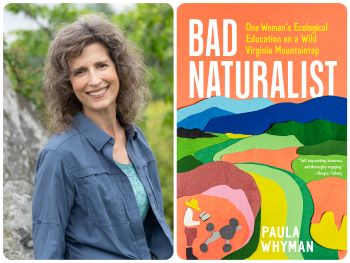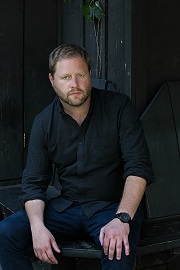The memoirist talks environmentalism for the rest of us.

In her debut memoir, Bad Naturalist, fiction writer Paula Whyman (You May See a Stranger) chronicles her attempt to restore a 200-acre former cow pasture in the Blue Ridge Mountains to its original state. Not an easy feat for a city girl, especially in the face of invasive plants, ravenous deer, and Whyman’s (and everyone’s, I’m thinking) fear of venomous snakes in the grass.
Her book might be compared to Isabella Tree’s The Book of Wilding or even Peter Mayle’s A Year in Provence (which, in Whyman’s case, would be Four Years and Counting), earlier works about each writer’s tangles with environmental fixer-uppers.
But lest you worry that you need an advanced degree in botany or soil irrigation to grasp her story, Whyman uses comedic timing and nifty analogy to explain what might happen, say, when a native plant is crossed with a cultivar, producing a hybrid with undesirable traits. “It’s like replacing the chocolate chips in your favorite cookies with corn kernels,” she writes. “No one is going to eat that.”
Whyman says her work on the pasture will be “ongoing and endless” — and, thanks to her newsletter, in which she continues to document her progress, a real bounty for readers.
When in the restoration process did you think, “Hey, maybe I should be taking notes for a book”?
When I started the mountaintop restoration, I was working on a novel. I can’t even tell you right now what that novel was about; it’s somehow completely gone from my mind. I was so totally preoccupied with figuring out what was happening on the mountain, what was living and growing here, and how to make it a better place for native plants, bees, birds, and other wildlife, I couldn’t think about anything else. I need to be obsessed with whatever I’m writing in order to stick with it and make it work, so it seems natural that by a few months into the mountain project, I started thinking that this was indeed the book I needed to write. It was fortunate that, by the time I had that epiphany, I was already keeping a journal [and] taking lots of notes and photos about my experiences and what I was learning.
I found it fascinating that you treat the meadow as your co-protagonist in the book. Most of the action takes place on the mountain, and you don’t toggle between it and your regular life back in Bethesda, MD. Was that a deliberate choice?
I do think of the meadow as a “character” in every sense of the word. The place definitely controlled the narrative a lot of the time! I always envisioned this as a story about the mountain and my efforts there, my learning curve following the rather impulsive decision to take on a big project like this when I knew so little about certain aspects of it, rather than a story about the contrasts between the mountain and the suburbs.
What fiction techniques did you rely on in writing this nonfiction book?
In nonfiction, as in fiction, I’m hoping to tell a story that the reader finds compelling, and for me, that means it needs to include tension and conflict, selective details, a setting that I hope the reader can easily visualize, and dialogue that is authentic and not too long-winded. And finally, the use of humor in the narrative is, for me, apparently unavoidable, whether I’m writing fiction or nonfiction.
How did you handle writing about real people — your husband, for example? I noticed he doesn’t get the full-name treatment here.
My husband is a private person, and I wanted him to feel comfortable, so he got veto power over how I mentioned him. (Only people I live with get veto power!) I also don’t name my kids because I feel like they’re entitled to their privacy — it’s not their fault their mom is a writer! My parents, on the other hand, were totally fair game, and some of my favorite stories are about them. Fortunately, they didn’t mind!
What do you hope readers take away from your story? Is there a subtle call to action here?
First of all, I hope readers will be entertained! There’s no assignment here! Feel free to simply live vicariously through my bumbling…But I would love it if my story inspired people to look more closely at the natural world wherever they happen to find themselves, whether that’s in the city, suburbs, or the countryside — birds on the wire, plants in the cracks of the sidewalk, in window boxes, back yards, and city parks. For me, paying closer attention increased my interest and curiosity about plants and creatures, and it drove me to want to know more about the interconnections among them. And the more I learned, the more I wanted to do something to help.
And you don’t need hundreds of acres to have an impact! Start small and start with something you care about. Maybe you’ve noticed a park near you that could use a little TLC — maybe they’re open to volunteers. Or it could mean planting a native flower in your window box or in a corner of your yard — in the spring, when you see native butterflies visit that flower, that’s such a rewarding feeling. Then, in the winter, the birds may come and pick the seeds from that flower. Watching what happens, and knowing that you made it happen, is empowering and motivating. When you know that you did this, you changed this small corner of the world — it might not have happened otherwise — that’s powerful.
[Editor’s note: Paula Whyman will be in conversation with Dana Milbank at Politics and Prose in Washington, DC, tonight at 7 p.m. Learn more here.]
[Photo by Doug Sanford.]
Cathy Alter is a member of the Independent’s board of directors and the author, most recently, of CRUSH: Writers Reflect on Love, Longing, and the Power of Their First Celebrity Crush.
